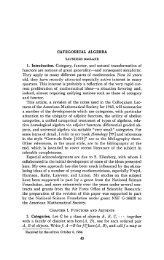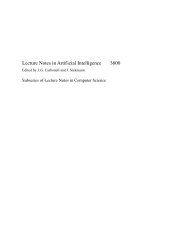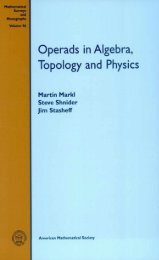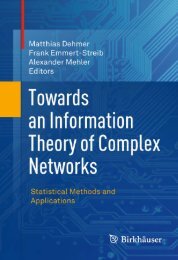Symmetric Monoidal Categories for Operads - Index of
Symmetric Monoidal Categories for Operads - Index of
Symmetric Monoidal Categories for Operads - Index of
You also want an ePaper? Increase the reach of your titles
YUMPU automatically turns print PDFs into web optimized ePapers that Google loves.
3.1 Recollections: <strong>Operads</strong> 55<br />
In the point-set context, we use the notation p(q1,...,qr) ∈ P(n1+···+nr)<br />
to refer to the composite <strong>of</strong> the elements p ∈ P(r) andq1 ∈ P(n1),...,qr ∈<br />
P(nr) in the operad. The unit morphism is determined by a unit element<br />
1 ∈ P(1).<br />
3.1.3 Partial Composites. We also use partial composites<br />
defined by composites<br />
P(r) ⊗ P(s) ◦e<br />
−→ P(r + s − 1),<br />
P(r) ⊗ P(s) � P(r) ⊗ (1 ⊗···⊗P(s) ⊗···⊗1)<br />
→ P(r) ⊗ (P(1) ⊗···⊗P(s) ⊗···⊗P(1)) μ −→ P(r + s − 1),<br />
where operad units η : I → P(1) are applied at positions k �= e <strong>of</strong> the tensor<br />
product. In the point-set context, we have p ◦e q = p(1,...,q,...,1), where<br />
q ∈ P(s) issetattheeth entry <strong>of</strong> p ∈ P(r).<br />
The unit and associativity relations imply that the composition morphism<br />
<strong>of</strong> an operad is determined by its partial composition products. The unit<br />
and associativity relations <strong>of</strong> the composition morphism have an equivalent<br />
<strong>for</strong>mulation in terms <strong>of</strong> partial composition products (see [46]).<br />
3.1.4 The Intuitive Interpretation <strong>of</strong> <strong>Operads</strong>. The elements <strong>of</strong> an<br />
operad p ∈ P(n) have to be interpreted as operations <strong>of</strong> n-variables<br />
p = p(x1,...,xn).<br />
The composition morphism <strong>of</strong> an operad models composites <strong>of</strong> such operations.<br />
The partial composites represent composites <strong>of</strong> the <strong>for</strong>m<br />
p ◦e q = p(x1,...,xe−1,q(xe,...,xe+n−1),xi+n,...,xm+n−1),<br />
<strong>for</strong> p ∈ P(m), q ∈ P(n). The action <strong>of</strong> permutations w ∈ Σn on P(n) models<br />
permutations <strong>of</strong> variables:<br />
wp = p(x w(1),...,x w(n)).<br />
The unit element 1 ∈ P(1) has to be interpreted as an identity operation<br />
1(x1) =x1.<br />
3.1.5 Free <strong>Operads</strong>. The obvious <strong>for</strong>getful functor U : O → M from<br />
operads to Σ∗-objects has a left adjoint F : M→Owhich maps any Σ∗object<br />
M to an associated free operad F(M).<br />
In the point-set context, the free operad F(M) onaΣ∗-object M consists<br />
roughly <strong>of</strong> all <strong>for</strong>mal composites<br />
(···((ξ1 ◦e2 ξ2) ◦e3 ···) ◦er ξr






